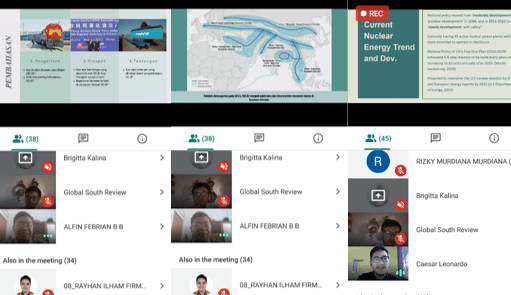
Yogyakarta, September 18th 2020—Institute of International Studies (IIS) FISIPOL UGM held a discussion which brought the topic about China: Initiatives in the Energy and Transportation Sector. In this occasion, there were two speakers, Alfin Febrian Basundoro, the Deputy Chairman of the Department of Reasoning of UPII UGM, and Caesar Leonardo, Director of The Student Association of Belt and Road Initiative (SABRI) Chapter UGM, it was moderated by Handono Ega P., the Staff of Publication of IIS FISIPOL UGM. This event which was held on Google Meet began at 03.00 p.m. and it was divided into two sessions: material explanation and question and answer.
Opening the first session, the moderator gave a little explanation to guide the direction of the discussion. The presentation of the material was delivered by Alfin who specifically explained about the New Eurasian Land Bridge: China’s Railway Sector Expansion. “NELB is a new railway line that connects China, Central Asia, and a number of countries in Europe. NELB itself is a development of the Eurasian Land Bridge, which has passed through the Trans Siberian Railway in Russia since 1990 with a route through the southern route.” In some sources, the NELB is considered to be the “Modern Silk Route” connecting Asia and Europe through one main trade route.
The existence of NELB provides several advantages or prospects for China, namely related to transportation effectiveness, increasing EU-China trade, and commodity diversification. Meanwhile, more broadly, the existence of this NELB also provides positive prospects for the Eurasia region, including in relation to the opening of a free trade zone, and can increase connections in the Central Asian region. However, to develop this NELB there are several challenges that must be faced including the availability of infrastructure, the existence of quality human resources, and the effectiveness of the bureaucracy.
Continuing the previous discussion, Caesar Leonardo explained something related to the Chinese Nuclear Energy Initiatives. “The existence of nuclear energy sources in China is inseparable from industrial development in the region. Please note that China requires 22 percent of the total global energy to carry out industrial activities,” Caesar said opening his explanation session. In his explanation, Caesar also said that when compared to other countries that also use nuclear energy to carry out economic activities, China is classified as a new player. So far, the tendency of China’s own energy sources is more towards the use of coal and oil. Therefore, by using nuclear power, there is a renewable energy source with a more sustainable prospect. In this case, if it is compared to other energy sources, the emission level of nuclear power is lower, even equivalent to the emission level of wind energy sources.
After the presentation of the two speakers, the discussion entered the second session, a question and answer session with the participants. One of the interesting questions came from Faiz Rafiza Ahmadani related to NELB, if it is compared to the broader route. Responding to this question, Alfin revealed that the existence of NELB does not mean a complement to the other two routes. In this case, NELB complements other areas because of several advantages including travel time and conduciveness. The discussion went well and ended at 05.00 p.m.
